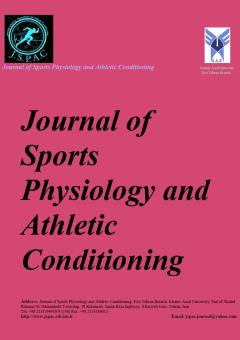Relationship between erythropoietin and fasting glucose glucose after a resistance training program in male Wistar rats with type 2 diabetes
Subject Areas : Sport Physiology
Farshad Sadeghi
1
,
Yaser Kazemzadeh
2
*
![]() ,
Abdolali Banaeifar
3
,
Sajad Arshadi
4
,
Abdolali Banaeifar
3
,
Sajad Arshadi
4
1 - PhD. student of exercise physiology, Department of Physical Education and Sports Sciences, Islamshahr Branch, Islamic Azad University, Islamshahr, Iran.
2 - Graduated from Kharazmi University, Tehran, Iran.
3 - Associate Professor, Department of Physical Education and Sports Sciences, South-Tehran Branch, Islamic Azad University, Islamshahr, Iran.
4 - Department of Exercise Physiology, South Tehran Branch, Islamic Azad University, Tehran, Iran
Keywords: Resistance training, type 2 diabetes, erythropoietin, fasting blood glucose,
Abstract :
Background: Erythropoietin is known as a strong stimulant in the activation of satellite cells and increasing the regeneration function of muscle tissue. The purpose of this study was to investigate the relationship between erythropoietin concentration and fasting blood glucose after a resistance training program in male Wistar rats with type 2 diabetes. Materials and Methods: Twenty-four male rats aged 6 weeks were divided into 3 groups: healthy control (n=8), diabetic control (n=8) and resistance training (n=8). Resistance exercises were performed for 8 weeks, 5 sessions per week, with an intensity of 100-30% of the weight of the rats in the resistance training group. In the last week of the training program, the maximum oxygen consumption of the rats was taken using the executive protocol on the rat treadmill. 48 hours after finishing the training program, blood samples were taken from the right ventricle of heart of the rats and erythropoietin and fasting blood glucose were evaluated. The data was statistically analyzed using Pearson's correlation and one-way analysis of variance at the alpha level of less than 0.05. Results: The results showed that there is no significant relationship between erythropoietin and fasting blood glucose among any of the groups. Also, performing 8 weeks of resistance training in diabetic rats led to an increase in erythropoietin concentration (P≤0.0001) and a decrease in blood glucose (P≤0.0001). Conclusion: It seems that more stimulation of EPO and regeneration of muscle tissue as well as increased energy consumption in muscle tissue is one of the possible mechanisms of blood glucose reduction caused by 8 weeks of resistance training in diabetic rats

